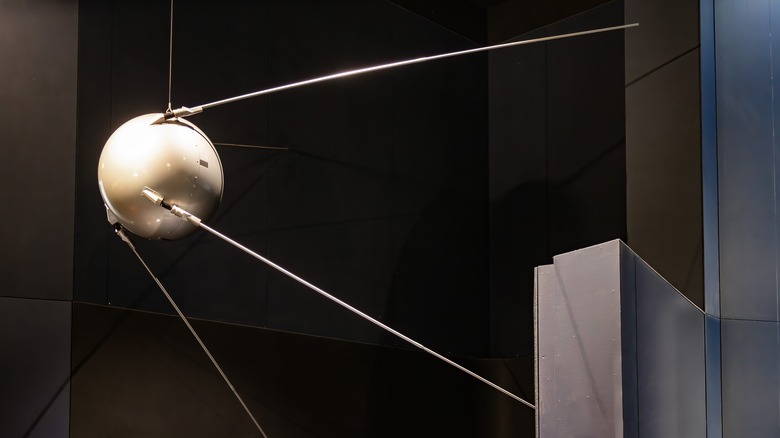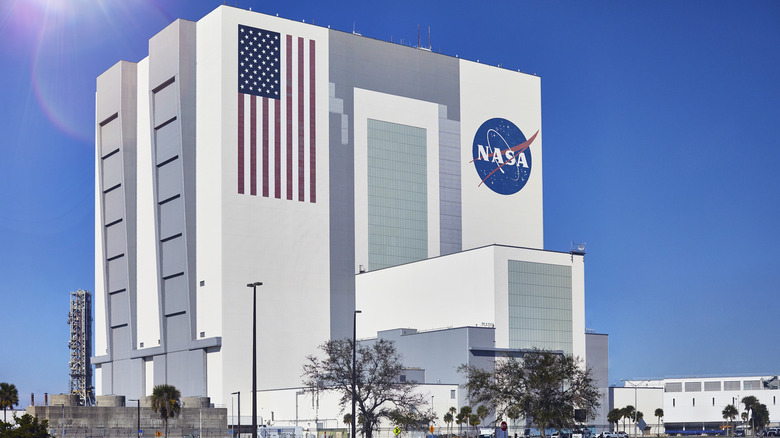How Did Sputnik Work, And What Did It Actually Do?
Earth's Space Age began on October 4, 1957, when the Soviet Union successfully launched the first human-made satellite into space, much to the surprise and disappointment of the United States government. While launching objects into space is commonplace today, in the midst of the Cold War in the 1950s, it was a major demonstration of a country's strength. Sputnik orbiting Earth contributed to a growing sense of fear that the U.S. was not nearly as technologically advanced as its Russian rivals. In comparison, the U.S. tested several rockets and missiles throughout the rest of the decade without success.
Sputnik was the size and shape of a basketball with a diameter of 23 inches and four antennae protruding from its body. While it was small in stature, it weighed 184 pounds. Encased inside its spherical body were two radio transmitters powered by three silver-zinc batteries that died only 22 days after the satellite was put in orbit. They may have lasted for less than a month, but that exceeded all expectations.
Furthermore, the batteries dying before a month's time didn't stop Sputnik from staying in orbit. The satellite orbited Earth for a total of 92 days before it broke apart and fell back to Earth. It had no boosters like satellites today, so repositioning it wasn't a possibility. Despite its quick run, Sputnik still served a scientific purpose and had a specific mission — although, it wasn't as nefarious as many thought at the time.
Sputnik-1 had five primary objectives
Modern satellites transmit messages across the planet and take incredibly detailed photographs of the cosmos. Sputnik didn't have all the features of today's satellites, but it was sent to space with five objectives to complete. First of all, scientists at the time had many questions or theories about how best to get an object in Earth's orbit, so getting Sputnik up there was a way to test those. Second, the Soviets used Sputnik to get a better idea of the atmosphere's density, using the amount of time it took the satellite to decay to come to their conclusions.
Many who were alive for this monumental achievement can remember listening to the little chirps the satellite transmitted through radio waves. Sputnik's broadcast lasted a total of 0.3 seconds, followed by a pause just as short and then a repeated chirping sound. According to NASA, this was a test of the third objective: to help "determine the effects of radio wave propagation though the atmosphere." The final two scientific questions Sputnik set out to answer had to do with verifying principles of pressurization in space through its nitrogen-pressurized hull and helping scientists better understand how to track objects in orbit.
If there were ever any concerns that Sputnik-1 was a technologically advanced spy satellite, those concerns were unnecessary. There was a long list of spy satellites that soared through space during the Cold War, but Sputnik-1 was not one of them.
Sputnik kicked the U.S. space agency into action
The Soviet Union was originally working on a 3,000-pound satellite to send up, but its desire to beat the United States to space prompted it to send the considerably smaller satellite first. Tensions were high between the USSR and the U.S., and Sputnik concerned the U.S. government. Sure, President Eisenhower kept his calm about the event when he addressed the country, but afterward he increased funding to necessary agencies in an attempt to keep up with Russia.
Frustrated with the infighting between the different military branches while trying to launch a satellite, Eisenhower approved the formation of a civilian space agency that would work with the already existing National Advisory Committee on Aeronautics (NACA). On July 29, 1958, President Eisenhower helped with the creation of NASA by signing the National Aeronautics and Space Act. Without Sputnik, NASA might never have been devised and the U.S. might not have ever made it to the moon.
Using a rocket to get a satellite into space increased fears that the USSR was closer to creating an intercontinental ballistic missile (ICBM) that could strike the U.S. as well. As a result of this fear, U.S. leaders also created the Defense Advanced Research Projects Agency (DARPA).


